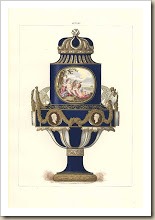 A fine piece of Sevres porcelain fetched almost a million dollars at the end of 2011, when it was bought by the Metropolitan Museum of Art. It is such a huge amount of money for one item that the majority of people would not consider the prospect. On the other hand, beautiful original antique lithographs of the finest pieces of Sevres porcelain can be framed nicely, hung on the wall, and are not nearly as fragile when dusting. In a lounge or dining room, a group of framed porcelain lithographs definitely adds style - whether hung as a formal matching set, or an informal group of different styles of porcelain.
A fine piece of Sevres porcelain fetched almost a million dollars at the end of 2011, when it was bought by the Metropolitan Museum of Art. It is such a huge amount of money for one item that the majority of people would not consider the prospect. On the other hand, beautiful original antique lithographs of the finest pieces of Sevres porcelain can be framed nicely, hung on the wall, and are not nearly as fragile when dusting. In a lounge or dining room, a group of framed porcelain lithographs definitely adds style - whether hung as a formal matching set, or an informal group of different styles of porcelain.
The manufacture of fine porcelain in Europe was not achieved until four hundred years after Portuguese and Dutch travellers first returned with Kaolin or ‘hard’ porcelain from China. In Germany, the origin of soft porcelain is controversial. When it was rumoured that alchemist Johann Friederich Bottger was experimenting with converting base metals to gold, King Augustus II detained him in Dresden, the capital of Saxony. In 1704 Ehrenfried Walther von Tschirnhaus was appointed his controller and worked with Bottger. Instead of gold, in 1709 the first Dresden porcelain was manufactured. It is usually Bottger who is credited, though some believe documentation indicates Tschirnhaus was responsible. In any case, the King protectively established a factory inside the walls of Albrechtsburg castle in nearby Meissen.
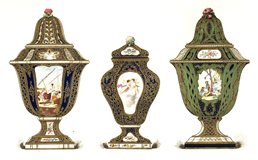
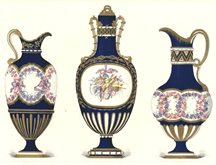
The French have always been recognized for stylish objet d’art, but the popularity of Dresden porcelain from Saxony inspired the French to greater efforts in making finer porcelain. New factories sprang up around France – at Lille in 1711, Chantilly in 1725, and at Mennecy around 1735. The porcelain developed at Chantilly, with its finer enamel glaze, soon gained greatest recognition.
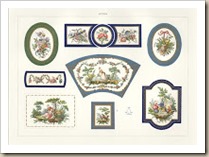 Gilles and Robert Dubois, duplicitous employees from Chantilly, persuaded the brother of the Comptroller-general of Finance in France, Orry de Fulvy, to establish a factory in 1738 at the old Chateau of Vincennes. Ignominious departure followed their unsuccessful endeavours, and fellow-worker Louis-Francois Gravant was left to develop the experiments of the brothers. In 1748, a new Comptroller-general of Finance, Count d’Arnouville, with his intellectual benefactor, Louis XV’s mistress Madame de Pompadour, recommended Louis XV extend his patronage of the factory at Vincennes. In 1756 the factory was established at Sevres, between Paris and Versailles – closer to the royal residence.
Gilles and Robert Dubois, duplicitous employees from Chantilly, persuaded the brother of the Comptroller-general of Finance in France, Orry de Fulvy, to establish a factory in 1738 at the old Chateau of Vincennes. Ignominious departure followed their unsuccessful endeavours, and fellow-worker Louis-Francois Gravant was left to develop the experiments of the brothers. In 1748, a new Comptroller-general of Finance, Count d’Arnouville, with his intellectual benefactor, Louis XV’s mistress Madame de Pompadour, recommended Louis XV extend his patronage of the factory at Vincennes. In 1756 the factory was established at Sevres, between Paris and Versailles – closer to the royal residence.
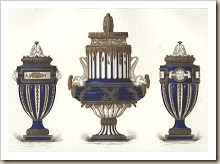 Louis XV decreed that the soft porcelain of Sevres was Manufacture Royale de la Porcelaine de France, so it became known as the "Royal Porcelain of France". The Director of the Academy of Sciences in Paris, Monsieur Jean Hellot, was appointed to closely manage all aspects of porcelain manufacture. Duplessis, a skilful artist and Court Jeweller, was commissioned to design the forms and supervise their creation. Painting and gilding was supervised by enamel painter, Mathieu, and later by Bachelier. The result was the exquisite porcelain simply referred to as Sevres. During the twenty-year exclusive royal contract and monopoly in the production of fine porcelain in France, the deep colours and fine glazes from the Sevres factory established a reputation across Europe for the most superior of all porcelain.
Louis XV decreed that the soft porcelain of Sevres was Manufacture Royale de la Porcelaine de France, so it became known as the "Royal Porcelain of France". The Director of the Academy of Sciences in Paris, Monsieur Jean Hellot, was appointed to closely manage all aspects of porcelain manufacture. Duplessis, a skilful artist and Court Jeweller, was commissioned to design the forms and supervise their creation. Painting and gilding was supervised by enamel painter, Mathieu, and later by Bachelier. The result was the exquisite porcelain simply referred to as Sevres. During the twenty-year exclusive royal contract and monopoly in the production of fine porcelain in France, the deep colours and fine glazes from the Sevres factory established a reputation across Europe for the most superior of all porcelain.
Lithographs of Sevres Porcelain. 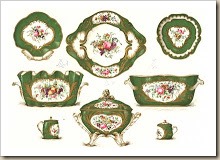
The luminosity of the rich colours and gilding of Sevres porcelain is beautifully represented in the colour-printed lithographs by Claude Gillot. To illustrate the fine Sevres porcelain manufactured during the glory years of production in the 18th and 19th centuries 'The Soft Porcelain of Sevres' Le Porcelaine Tendre de Sevres by Edouard Garnier was published circa 1890 in Paris, London and New York. These are still the most magnificent illustrations ever done of porcelain.
Hung on the wall with elegant framing these original antique porcelain prints can provide even greater impact than individual pieces of fragile porcelain, are less expensive.. and easier to look after. You will find a great selection on our website at http://www.antiqueprintclub.com/c-24-porcelainartifacts.aspx
or 'take to the hills' with a picnic if you wish. Arrange a visit to the Antique Print Clubhouse in the Gold Coast Hinterland. We're an hour south of Brisbane. By prior arrangement: 0412 442 283 or sales@antiqueprintclub.com